Compare ovens for free with Canstar Blue!
Indoor vs. outdoor pizza ovens
Indoor and outdoor pizza ovens serve the same fundamental purpose of baking pizzas, but there are key differences between the two types based on their design, features, and suitability for specific environments. Here are some considerations for indoor and outdoor pizza ovens:
Indoor pizza ovens
Pros:
- Convenience: indoor pizza ovens offer the convenience of being easily accessible within your kitchen, allowing you to prepare pizzas without going outside
- Year-round use: regardless of weather conditions, you can use an indoor oven year-round, as it is not affected by outdoor elements
- Temperature control: indoor pizza ovens often provide precise temperature control, allowing for consistent and accurate cooking results
- Ventilation systems: many indoor pizza ovens are equipped with effective ventilation systems to expel smoke and odors, ensuring a cleaner and more pleasant cooking environment
Cons:
- Installation requirements: some indoor ovens may require professional installation, especially those built into walls or cabinetry, adding to the overall cost
- Lack of traditional flavour: electric or gas-powered indoor ovens may not provide the traditional smoky flavour associated with wood-fired outdoor pizza ovens
Outdoor pizza ovens
Pros:
- Traditional flavour: wood-fired outdoor pizza ovens impart a distinct smoky flavour to pizzas, providing a traditional and authentic taste
- High cooking temperatures: outdoor ovens can reach high temperatures quickly, resulting in fast and evenly cooked pizzas with crispy crusts
- Social gathering: outdoor ovens create a focal point for socialising, making them a centerpiece for outdoor gatherings and events
- Large capacity: outdoor pizza ovens are often larger, allowing for the simultaneous cooking of multiple pizzas or other dishes, making them ideal for entertaining
Cons:
- Weather dependence: outdoor ovens are exposed to weather conditions, limiting their use during inclement weather, especially in extreme temperatures or rain
- Space requirements: built-in outdoor ovens may require more space in your backyard or outdoor kitchen, limiting their suitability for smaller outdoor areas
- Smoke and mess: while outdoor ovens are designed to dissipate smoke naturally, they can still contribute to a smoky atmosphere, which may affect nearby surroundings. And the ashes that come with burning solid fuels are messy to clean up
- Less control over temperature: outdoor wood-fired ovens may have less precise temperature control compared to indoor electric or gas ovens, and can be difficult to master
- Initial cost and installation: quality outdoor pizza ovens, especially built-in models, can be expensive. Some may also require professional installation, adding to the overall cost
Ultimately, the choice between an indoor and outdoor pizza oven depends on your preferences, available space, and intended use. Indoor ovens offer convenience and controlled environments, while outdoor ovens provide a more versatile and often traditional experience.
Pizza oven brands
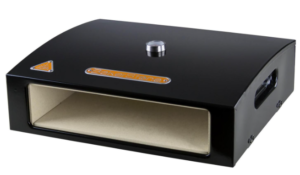
Bakerstone
Bakerstone currently has one pizza oven available in New Zealand. The Bakerstone Basics Pizza Oven converts a smaller gas BBQ into a gourmet pizza oven. The unique design raises the temperature of outdoor grills to that of a real wood burning pizza oven.
Features:
- Bakes perfect pizzas using convective, conductive and radiant heat
- Fits on a kettle BBQ
- Enamel steel exterior
- Full surround ceramic interior
- Cooks pizza in 2-4 minutes
- Works on most BBQs
- Includes dust cover
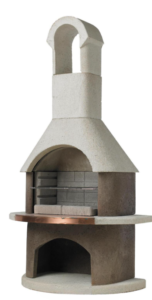
Buschbeck
The Buschbeck collection, which is available at Mitre 10, features a range of outdoor pizza ovens, all built from quartzite concrete. Double-walled firebox construction means you can use charcoal or wood as fuel.
Features:
- Multi functional three-in-one fireplace, pizza oven, and BBQ
- Easy DIY Kitset
- Four rack positions for grilling
- Wood storage area
- Optional pizza oven insert, rotisserie, ash pan, cast-iron grill, base & chimney extensions available
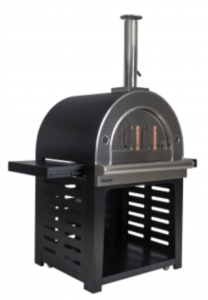
Masport
Masport retails three pizza ovens in New Zealand:
- Side Burner Pizza Oven ($207)
- Table Top Pizza Oven ($529)
- Wood Fired Oven ($3199)
Masport’s premium pizza oven offering is the Matador Woodfired Pizza Oven. It is perfect for cooking pizza, baking breads and roasting your favourite meals, all while delivering that authentic “wood fired” flavour.
The insulated oven includes a heavy stainless steel liner for improved heat retention, ideal for when extended cooking times are required. Despite its name, the Masport’s Woodfired Pizza Oven be used with BBQ briquettes and charcoal, as well as firewood.
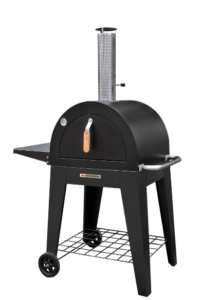
Matador
Matador has one pizza oven on offer in New Zealand. The Matador wood-fired pizza oven is a great size to cook for the family and to entertain with friends. The pizza oven is packed with features, including an easy one-hand hinged door, large side shelf, wheels for easy manoeuvrability and a double layer stainless steel chimney.
Features:
- Adjustable chimney vent
- Trolley stand with wheels
- High temperature powder coated pizza oven surround and fascia
- Black powder coated side shelf
- Includes temperature gauge mounted in oven fascia
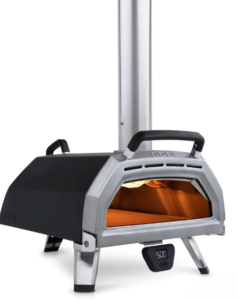
Ooni
Oonio offers a range of pizza ovens, ranging from $599 to $1599. Ooni’s pizza ovens come in two sizes, featuring space for:
- 16-inch pizza
- 14-inch pizza
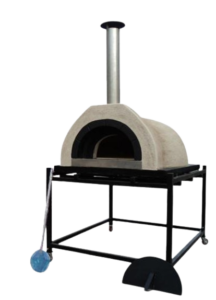
Trendz
Trendz has two outdoor pizza ovens on the market: the Grande and the Bambino Elite.
The Grande’s concrete single-piece shell delivers even heat distribution that remains contained within the oven for hours on end.
Offering the same authentic taste but in a space-conscious package, the Bambino Elite is ideal for smaller outdoor areas or when the pizza oven doesn’t need to be the main feature.
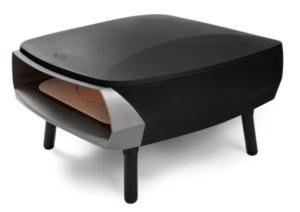
Witt
Witt has one pizza oven available, at Mitre 10: the Witt Rotante Gas Pizza Oven. Powered by gas, Witt claims it can cook a whole pizza in one minute.
Features:
- Heats up to 500 degrees Celsius in 15 minutes
- Rotating ceramic pizza stone
- Separate gas burner for pizza base cooking
- U gas-ring burner for even cooking for toppings
- Collapsible legs for portable transportation
How much do pizza ovens cost?
Indoor pizza ovens
The cost of an indoor pizza oven can vary based on factors such as the type of oven, brand, features and size. Prices can from a few hundred dollars to well over $1000.
- Small countertop electric pizza ovens suitable for indoor use may start from around $100 and can go up to $500 or more
- Built-in electric or gas wall ovens with pizza cooking features can range from $500 to $2000 or higher, depending on the brand and additional features
- Indoor wood-fired pizza ovens, which may require professional installation, can start from $1000 and go up to several thousand dollars
Outdoor pizza ovens
Just like indoor pizza ovens, the price of an outdoor oven can vary depending on various features, including size and functionality. It’s important to note that prices are subject to change, and various promotions, sales, and new models may impact the cost of outdoor pizza ovens.
- Portable outdoor pizza ovens, designed for backyard use or camping, can start from $200 and go up to $1500 or more
- Standalone wood-fired outdoor pizza ovens, which are larger and more traditional in design, may range from $1500 to $3000 or higher
- Built-in or DIY outdoor pizza ovens, which may be part of an outdoor kitchen setup, can start from $1000 and go up to several thousand dollars, depending on size and features
- Gas or electric outdoor pizza ovens, offering convenience and quicker heating, may have a price range of $800 to $2000 or higher
- Commercial-grade outdoor pizza ovens, designed for high-volume use, can be significantly more expensive, with prices starting from $10,000 and going up based on capacity and extra features
Alternatives to pizza ovens
If you don’t have access to a pizza oven or are looking for alternative ways to make pizza at home, there are several options available. Here are some alternatives to traditional pizza ovens:
Conventional oven: use a conventional kitchen oven. Preheat it to the highest temperature possible (usually around 260°C) and bake your pizza on a pizza stone or a baking sheet.
Pizza stone or baking steel: place a pizza stone or baking steel in your conventional oven. Preheat the stone or steel along with the oven and then bake your pizza directly on it for a crispy crust.
Cast iron skillet: preheat a cast iron skillet on the stovetop and then finish cooking the pizza under the grill for a crispy crust.
Grill: preheat your outdoor grill to a high temperature. Cook the pizza directly on the grill grates or use a pizza stone on the grill for a smoky flavour.
Electric pizza maker: use an electric pizza maker or countertop pizza oven, which is a compact appliance designed specifically for making pizzas.
Toaster oven: if you have a toaster oven, you can use it to bake small pizzas. Preheat the toaster oven and cook the pizza directly on the rack or on a baking sheet.
Experimenting with these alternatives allows you to find the method that best suits your preferences and available equipment. Each method may produce slightly different results, so it’s worth trying a few to see which one you like best.
Each year Canstar Blue rates NZ power companies for customer satisfaction and value for money. You can see the table below for some of the results, or you can click on the button below for the full results of our survey.
Canstar Blue’s latest review of NZ power companies compares them on customer satisfaction. The table below is an abridged version of our full results, available here.
^ By clicking on a brand or 'details' button, you will leave Canstar Blue and be taken to either a product provider website or a Canstar Blue NZ brand page. You agree that Canstar Blue NZ’s terms and conditions apply (without limitation) to your use of this service,to any referral to a product provider from our website, and any transaction that follows. Canstar Blue may earn a fee for referrals from its website tables, and from sponsorship (advertising) of certain products. Payment of sponsorship fees does not influence the star rating that Canstar Blue awards to a sponsored product. Fees payable by product providers for referrals and sponsorship may vary between providers, website position, and revenue model. Sponsorship fees may be higher than referral fees. Sponsored products are clearly disclosed as such on website pages. They may appear in a number of areas of the website such as in comparison tables, on hub pages and in articles. Sponsored products may be displayed in a fixed position in a table, regardless of the product’s rating, price or other attributes. The table position of a sponsored product does not indicate any ranking, rating or endorsement by Canstar Blue. See How we are funded for further details.
Canstar Blue NZ Research finalised in April 2023, published in June 2023.
See Our Ratings Methodology
Compare electricity providers for free with Canstar Blue!
About the author of this page
This page was written by Canstar Content Producer, Caitlin Bingham. Caitlin is an experienced writer whose passion for creativity led her to study communication and journalism. She began her career freelancing as a content writer, before joining the Canstar team.
Enjoy reading this article?
You can like us on Facebook and get social, or sign up to receive more news like this straight to your inbox.
By subscribing you agree to the Canstar Privacy Policy



Share this article